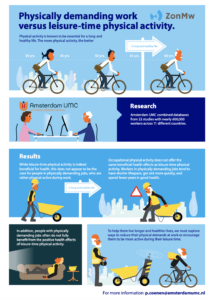We’ve all heard it before: “Physical activity is good for you.” But is that always true? While leisure-time physical activity like running or cycling certainly improves health, our new research suggests that physical activity at work may tell a different story.
Why is this study important?
While we all know that physical activity is good for our health (1), not all types of physical activity seem to offer these health benefits. In fact, what we do for work might not protect us as much as what we do during leisure time. Occupational physical activity — the exertion many people experience during their jobs — has been shown in previous studies to offer fewer health benefits compared to leisure-time physical activity, like going for a walk or to the gym after work (2).
In our recent study, published in the British Journal of Sports Medicine (3), we dug deeper into this question by analysing individual participant data (IPD) from a wide range of studies, examining both occupational and leisure-time physical activity and their association with all-cause mortality. Understanding these differences could be important for developing public health guidelines, particularly for individuals in physically demanding jobs.
How did the study go about this?
We used data from the Active Worker consortium, a rich source of data from 22 different cohort studies spanning 11 countries. This gave us a large and diverse sample of over 590,000 adults, aged 18-65 years, who were followed for an average of 23 years.
We used a two-step approach to analyse the data in an IPD meta-analysis. First, we analysed each study individually, using survival models to assess how both occupational and leisure-time physical activity were associated with all-cause mortality. Then, we pooled the results using random effect modelling to allow us to account for variations between the different studies.
We categorized both types of physical activity—work and leisure—into four levels: sedentary, low, moderate, and high. Our analysis also accounted for the factors: age, body mass index (BMI), smoking, education, and income.
What did the study find?
Our study revealed clear differences between the health effects of occupational and leisure-time physical activity. As expected, higher levels of leisure-time physical activity were consistently linked to a lower risk of death in both men and women (21% and 25% lower risk for men and women, respectively). In other words, staying active during your leisure time—whether through exercise or recreational activities—significantly reduces mortality risk.
However, when it comes to occupational physical activity, the story is different, especially for men. We found that men with moderate or high levels of occupational physical activity had a 5% and 12% higher risk of early death, respectively, compared to those with sedentary jobs. For women, there was no significant association between occupational physical activity and mortality.
Interestingly, when we adjusted for income in some of our models, the association between occupational physical activity and mortality weakened (from 12% to 2% higher risk for men, and from 3% lower to 2% higher risk for women), suggesting that socioeconomic factors may play a role in this association. However, even after considering these factors, our main conclusions remained unchanged.
Key Take-Home Points
Our study highlights an important distinction: not all physical activity benefits health. While leisure-time physical activity is clearly linked to lower mortality, occupational physical activity does not offer the same protective benefits—and in men, higher levels of occupational physical activity may even increase the risk of death. This challenges the popular public health message that any or all physical activity is good for you, and posits a new message around quality over quantity.
The key difference between occupational and leisure-time physical activity seems to lie in the nature of the activity. Voluntary, high-intensity activities such as running or cycling during leisure time are more likely to promote health, compared to the often repetitive, lower-intensity, and prolonged activities performed at work.
This suggests that public health guidelines could be more nuanced, particularly for individuals in physically demanding jobs. Relying solely on work-related physical activity may not be enough to maintain good health. Clinicians should encourage these individuals to incorporate additional leisure-time physical activity into their daily routines. However, it’s also important to recognize that the physical demands of their jobs may limit these workers’ capacity to engage in such activities—an issue that may require attention in both occupational health and public health strategies.

References
- Bull FC, Al-Ansari SS, Biddle S, Borodulin K, Buman MP, Cardon G, et al. World Health Organization 2020 guidelines on physical activity and sedentary behaviour. British journal of sports medicine. 2020;54(24):1451-62.
- Cillekens B, Lang M, van Mechelen W, Verhagen E, Huysmans MA, Holtermann A, et al. How does occupational physical activity influence health? An umbrella review of 23 health outcomes across 158 observational studies. Britsh Journal of Sports Medicine. 2020;54(24):1474-81.
- Coenen P, Huysmans MA, Holtermann A, Troiano RP, Mork PJ, Krokstad S, et al. Associations of occupational and leisure-time physical activity with all-cause mortality: an individual participant data meta-analysis. British journal of sports medicine. 2024.
Authors
Pieter Coenen and Bart Cillekens
Amsterdam UMC, department of Public and Occupational Health, Amsterdam, the Netherlands.